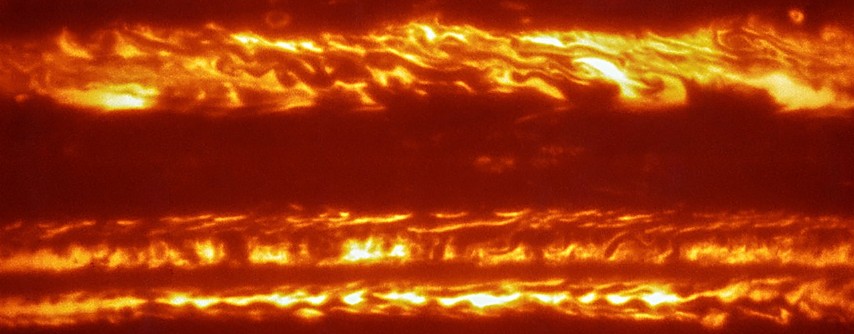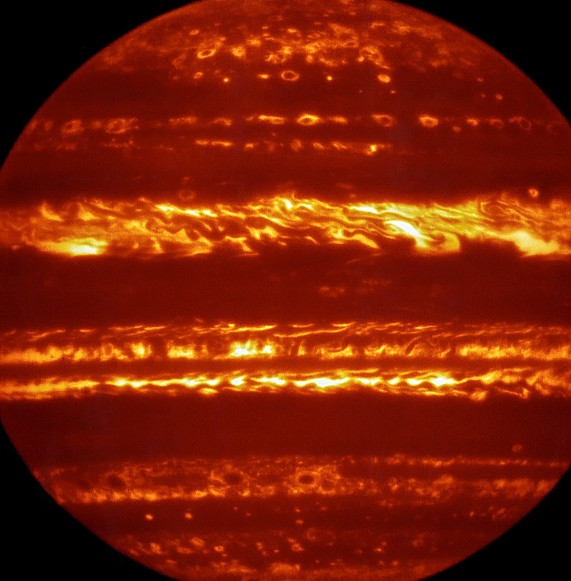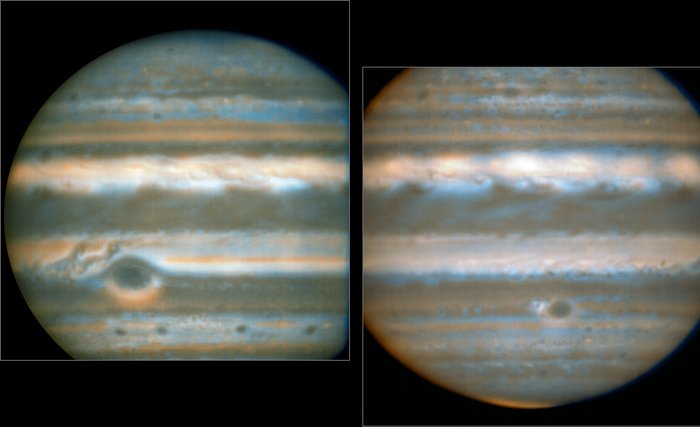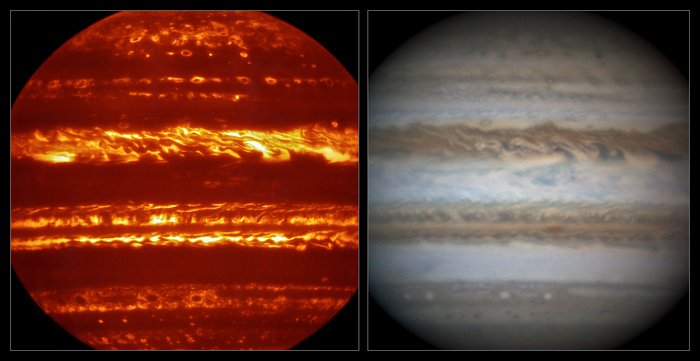New infrared images of Jupiter

Astronomers have used ESO’s Very Large Telescope to obtain spectacular new infrared images of Jupiter. They are part of a campaign to create high-resolution maps of the giant planet.
A team led by Leigh Fletcher of the University of Leicester in the United Kingdom have presented the new images at the UK’s Royal Astronomical Society’s National Astronomy Meeting in Nottingham this week. Obtained with the VISIR instrument on ESO’s Very Large Telescope, the new images are part of a focused effort to improve understanding of Jupiter’s atmosphere prior to the arrival of NASA’s Juno spacecraft in July this year.
The campaign has involved the use of several telescopes based in Hawaii and Chile, as well as contributions from amateur astronomers around the world. The maps do not just give snapshots of the planet, they also reveal how Jupiter’s atmosphere has been shifting and changing in the months prior to Juno’s arrival.
These maps will help set the scene for what Juno will witness in the coming months. Observations at different wavelengths across the infrared spectrum allow us to piece together a three-dimensional picture of how energy and material are transported upwards through the atmosphere.

This false-colour image was created by selecting and combining the best images obtained from many short VISIR exposures at a wavelength of 5 micrometers. Credit: ESO/L. Fletcher

False color images generated from VLT observations in February and March 2016, showing two different faces of Jupiter. The bluer areas are cold and cloud-free, the orangey areas are warm and cloudy, more colorless bright regions are warm and cloud-free, and dark regions are cold and cloudy (such as the Great Red Spot and the prominent ovals). The wave pattern over the North Equatorial Band shows up in orange. This view was created from VLT/VISIR infrared images from February 2016 (left) and March 2016 (right). The orange images were obtained at 10.7 micrometers wavelength and highlight the different temperatures and presence of ammonia. The blue images at 8.6 micrometers highlight variations in cloud opacity. Credit: ESO/L.N. Fletcher

False color images generated from VLT observations in February and March 2016, showing two different faces of Jupiter. The bluer areas are cold and cloud-free, the orangey areas are warm and cloudy, more colorless bright regions are warm and cloud-free, and dark regions are cold and cloudy (such as the Great Red Spot and the prominent ovals). The wave pattern over the North Equatorial Band shows up in orange. This view was created from VLT/VISIR infrared images from February 2016 (left) and March 2016 (right). The orange images were obtained at 10.7 micrometers wavelength and highlight the different temperatures and presence of ammonia. The blue images at 8.6 micrometers highlight variations in cloud opacity. Credit: ESO/L.N. Fletcher
Capturing sharp images through the Earth’s constantly shifting atmosphere is one of the greatest challenges faced by ground-based telescopes.
This glimpse of Jupiter’s own turbulent atmosphere, rippling with cooler gas clouds, was possible thanks to a technique known as lucky imaging. Sequences of very short exposures were taken of Jupiter by VISIR, producing thousands of individual frames. The lucky frames, where the image is least affected by the atmosphere’s turbulence, are selected and the rest discarded. Those selected frames are aligned and combined to produce remarkable final pictures like the ones shown here.
For high-resolution imagery, visit ESO
Featured image: ESO

Commenting rules and guidelines
We value the thoughts and opinions of our readers and welcome healthy discussions on our website. In order to maintain a respectful and positive community, we ask that all commenters follow these rules:
We reserve the right to remove any comments that violate these rules. By commenting on our website, you agree to abide by these guidelines. Thank you for helping to create a positive and welcoming environment for all.